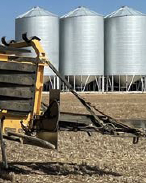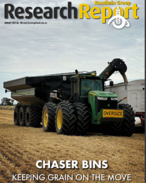This article is 7 years old. Images might not display.
With barley, farmers need to be thinking in terms of plant density rather than seeding rate," Dr Paynter said.
"Our research shows there is an optimum range of plant densities, depending on variety sown, and that yield and grain quality can be improved by growing barley crops within these ranges.
"The variety you are growing determines the target plant density rate." (Table 1, p54.)
The key concept is to calculate a seeding rate based on the variety you are growing. This begins with choosing your variety and sitting down with a small pile of seed and a set of kitchen scales.
"Once you have selected your variety, count out 1000 grains and weigh them. From this weight and your target plant density rate, you can calculate your seeding rate."
"If you are growing more than one variety, repeat this process for each variety."
Increasing seeding rate has a range of flow on effects on the barley crop, the combined effects of which give the optimum rate. As seeding rate increases, various crop measurements change. There are more plants established and more biomass six weeks after seeding. Plant height decreases but there is no effect on lodging risk. Grain yield increases, before plateauing. Kernel weight decreases and there is a slight decrease in hectolitre weight and increase in screenings. Grain protein concentration decreases and then plateaus. Grain brightness decreases slightly.
The DAFWA research took all these factors into account to calculate the optimum seeding densities for yield and profitability for the different barley varieties. The results show the optimum plant density for malt barley is 110-130 plants/m2 for Bass, Granger and Scope CL and 150-180 plants/m2 for Bass, Flinders and La Trobe. This is the density at which yield and profitability are maximised. For feed barley, densities above 180 plants/m2 are suggested.
"We're confident that our results apply in plus 1.5 tonne/ha environments," Blakely said. "Even in older trials, in years where the season got off to a difficult start, we saw profit drop when plant densities dropped below 100 plants/m2."
"In our trials, we pushed the seeding rate up to extreme levels and, even when we doubled it, we were not crashing the system like most people expected. This was especially the case in a dry season.
"You can add 10kg/ha to your seeding rate and it won't change grain quality. We needed to go to much higher seed rates to get small changes in quality.
"There's a lot of growers out there sowing barley light, but the evidence is that if you are growing below 100 plants/m2, you are missing out on profit.
"For some varieties, you can work through the calculations and end up with the same seeding rate. That's okay. You still know that you are sowing that rate for the right reason and that your plant density will be on target. We are talking about tweaking the system."
"At lower plant densities, there is huge variation in the flowering dates of individual tillers," Blakely said.
"As density increases, flowering becomes more synchronous as the number of main stems increases. It's logical to think that this would make the higher density plantings more susceptible to frost events, but we didn't see that in our trials in 2016, despite multiple frosts over the season. Our trials show it's not worth going low as a safeguard against frost.
"You can get more value out of some of the varieties by going to higher densities. More plants in the ground helps when things go wrong in the season like waterlogging.
"People believe that barley tillers up and yield recovers even at low planting densities, but it doesn't.
"Going low will cost yield. In a plus 1.5 tonne/ha area, planting at densities below 100 plants/m2 could be costing you 10% yield.
"Remember, the variety you sow determines your target density and this target sets your seed rate in kg/ha. Your target seed rate changes from variety to variety and from year to year. Seed rate in kg/ha is not fixed, but the target density is."
Contact:
Dr Blakely Paynter, DAFWA
08 9690 2115
blakely.paynter@agric.wa.gov.au






















